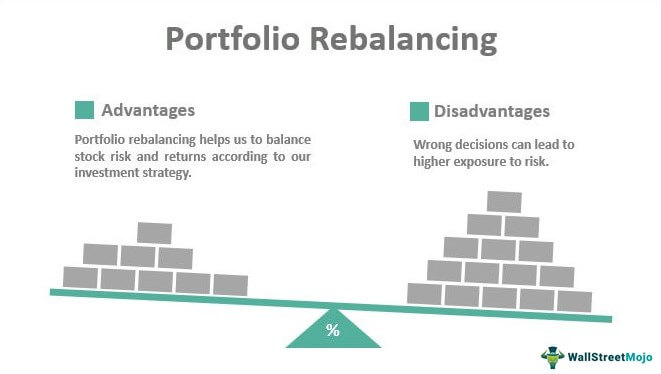Your investment portfolio says a lot about you.
Are you risk averse?
Or, are you more aggressive in your investing strategies?
Are you hoping to retire next year?
Or, are you optimizing for a 30-year plan?
Your portfolio should be a reflection of you. You are always changing – over the years, you’ll get new jobs, set different goals, and adapt to new environments – so your portfolio should be changing with you. That, in turn, means you need to rebalance your portfolio on a regular basis.
But what, exactly, does that mean? And how often should you be rebalancing? Should you rebalance with an advisor or have your roboadvisor do it for you?
Contents
What Does It Mean to Balance a Portfolio?
Balancing a portfolio simply means rearranging your assets and holdings to accurately fall in line with your goals and objectives. Usually, that means evaluating your risk profile, assessing your long-term and short-term goals, and studying the current state of the market to determine which balance of assets is going to work right for you.
For example, if the majority of your portfolio is currently in domestic stocks, but you’re feeling more risk averse than you used to, you might shift some of your assets away from stocks and toward safer investments like bonds.

The Importance of Rebalancing
It’s not enough to simply balance equally or one time. Most people need to rebalance their portfolio many times throughout the duration of their investing career. Why? The simple answer is because things change. At 30 years old, you’re going to see the world much differently than you saw it when you were 20 years old, so why would your financial portfolio look identical at each of these ages?
Over time, you’re going to go through a number of personal changes both related to your philosophical outlook and your financial potential. The world around you is also going to go through changes. Market dynamics are going to shift, new paradigms are going to emerge, and consensus thinking about certain types of assets are going to evolve.
The only way to keep up with all these changes and make sure your portfolio is capable of performing is to rebalance it at your intervals.
Considering Factors for Rebalancing a Portfolio

When considering how and when to rebalance a portfolio, you’ll generally need to consider the following:
- Time horizon. What is your investment time horizon? Most people invest with some end goal in mind, like hitting a target net worth or saving enough money to allow them to retire. Do you see yourself hitting that goal 30 years from now, or is your retirement right around the corner? These extreme ends of the spectrum will need to view portfolio balancing very differently; the closer you get to your end goal, the more risk averse you’ll become, and the more time-sensitive your rebalancing needs will be.
- Risk profile. Your risk profile should also dictate your portfolio rebalancing. Over time, your risk profile will change; for most people, aging is associated with risk aversion. As your risk tolerance changes, your balance of assets should also change.
- Long-term and short-term goals. You’ll also need to think about what your long-term and short-term goals are and how those goals are changing. You may have wanted to retire by age 50 last year, but is that still the case? Or do you have another objective in mind?
- Market and economic changes. Portfolio rebalancing isn’t just about your personal thoughts and philosophies. It’s also about the world around you. Over the course of years, some industries will struggle while new industries emerge. Asset classes will perform differently and be viewed differently. You’ll need to be able to reflexively respond to these changes.
- Other new information. Almost any kind of new information could be a viable motivation for rebalancing your portfolio in some way. For example, you may learn that the strategy you once held dear no longer is associated with a sizable return on investment. Or you may learn about new, potentially lucrative investment opportunities that weren’t on your radar previously.
Timing Your Portfolio Rebalances
So how often should you be rebalancing your portfolio?
For starters, you should understand that there are different types of portfolios and different types of investors. Some people employ a simple “buy and hold” strategy, dumping money into assets with the intention of letting them sit untouched for years, if not decades; these people don’t need to rebalance their portfolios very frequently. People take a more active approach, capitalizing on the latest trends to optimize their investments for the highest potential payoffs; these people will need to rebalance our portfolio as much more frequently.
Even so, you should commit to regular intervals of portfolio reassessment. Depending on what type of investor you are, that could be checking in on your portfolio once a year or once a month. Whatever you feel works best for you, stick to it regularly; you don’t have to shuffle your assets around every time you take a look at your portfolio, but you should be taking the time to consider the possibility.
You should also rebalance your portfolio outside of those regular intervals in response to major events. If we enter a new financial crisis, similar to the one that rocked the global economy in 2008, it’s a good idea to shift your portfolio in response. If you hear a new financial report that gives you concern about a specific area of the economy, like a forthcoming real estate crash or a looming tech bubble, you may also want to take action.
The Bottom Line
Most people should rebalance their portfolios, or at least critically examine their investment portfolios, on a regular basis – at least once a year, if not more frequently. If you have a higher-risk portfolio, or if you like to take a more active approach in your wealth management, you may need to assess and rebalance your investments even more frequently. You should also rebalance in the wake of new information, such as concerns about inflation or the rise of a new investment opportunity.
If you want to make smarter decisions with your investments and your portfolio balance, you’ll benefit from having an experienced, seasoned partner at your side. That’s why we’re here to help. Contact us for more information or for a free consultation today!
- How to Offset W-2 Income Taxes by Investing in Real Estate - July 19, 2024
- How to Invest in Real Estate Sight Unseen - July 16, 2024
- 19 Reasons Foreigners Should Invest in US Single-Family Real Estate - July 11, 2024

